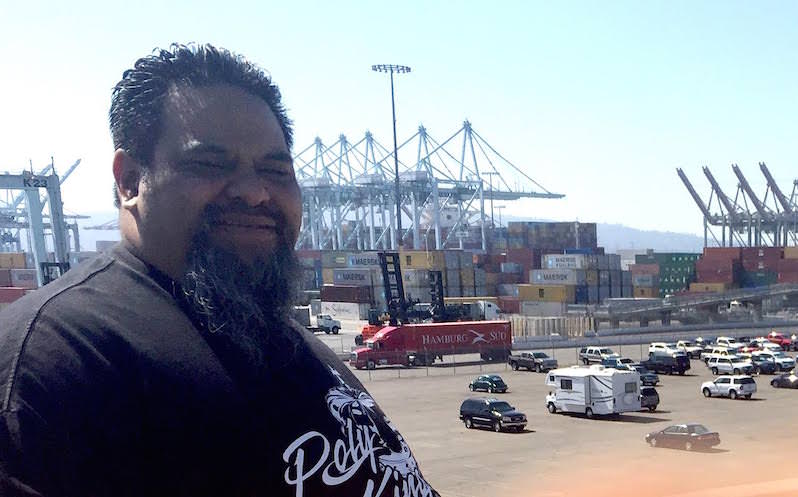Working-Class Struggles in Southern California Symbolize Blue-Collar Blues Across America
Far from the noise of the Donald Trump-Hillary Clinton brawl are painful examples of what this presidential campaign should be about: people struggling to raise their families out of poverty, send their kids to school and survive day to day.
Daniel Anseko Vaina, an independent truck driver, on a highway bridge overlooking the Port of Los Angeles. (Bill Boyarsky)
It should be named “the exploitation highway.” The path begins at the Los Angeles Harbor and extends about 100 miles east to the warehouses that process goods for Wal-Mart, Amazon and other retailers. These products are unloaded from container ships from Asian manufacturing plants, where labor is much cheaper than in the United States.
Here, far from the noise of the Donald Trump-Hillary Clinton brawl, are painful examples of what this presidential campaign should be about—$10-an-hour working people struggling to raise their families out of poverty, straining to send their kids to school, falling through holes in the safety net.
At the port, truck drivers—classified as “independent contractors”—wait in long lines to pick up loads. Driver Daniel Anseko Vaina told me he might get $185 a load to carry a container of Wal-Mart merchandise. From this, he subtracts $35 for fuel, $60 for the transportation company from which he leases his truck and another 5 to 10 percent for insurance, leaving him with less than $50 or $60 a day.
The trucks carry the containers to warehouses. Most are east of Los Angeles, in the area known as the Inland Empire. There, goods are stacked, often precariously, on pallets, and then sped to sorting tables.
Warehouse workers told me they receive about $10 an hour for dangerous work that offers no health or retirement benefits. One pallet knocked down Alejandra Lopez, 56. The company sent her to a clinic, which approved sending her back to work, despite extreme pains in her abdomen. She couldn’t make it. An attorney helped her get workers’ compensation, which paid for surgery. She cried as she told me her story.
I met these workers while pursuing another story. We’d been talking at Truthdig about whether white blue-collar manufacturing workers, left behind in the current economy, would vote for Trump. But Latinos are now the largest single ethnic group in California, especially in the southern part of the state. Manufacturing jobs are declining. The white blue-collar workers I interviewed earlier in my career have diminished in number, along with the auto, aerospace and other manufacturing plants that once employed them.
Instead of the story I set out to cover, my attention was caught by an article by professor Juan Lara of the University of Southern California: “Warehouse Work: Path to the Middle Class or Road to Economic Insecurity?”
That was connected with another story of working-class economic insecurity: that of truck drivers, deprived of regular pay, classified as independent contractors—as if they owned a business. Together, they amount to a story: the exploitation of hard-pressed working people, no matter their ethnicity.
Barb Maynard, a communications consultant for the Teamsters Union, which is trying to organize the drivers, introduced me to Vaina, a truck driver who goes by the nickname Seko.
We drove around the edges of the Port of Los Angeles, which occupies 7,500 acres of water and land. The adjoining Long Beach Port sprawls across another 7,600 acres. The shipping industry says these two ports account for nearly half of the sea cargo coming into the United States.
Classifying drivers such as Seko as independent contractors is a good deal for the trucking companies, which he said don’t have to pay salaries or benefits (drivers are paid by the company that receives the shipment upon delivery). Rather, money comes to the trucking companies from the drivers’ lease payments and parking fees for their trucks. The drivers buy fuel and supplies from the company—at the company store, you might say. As Tennessee Ernie Ford sang in “16 Tons,” “Saint Peter, don’t you call me ’cause I can’t go. I owe my soul to the company store.”
The companies say the arrangement gives the drivers the life of independent business people, able to choose their hours and working days. But the drivers’ days don’t allow for much independence. Seko said drivers begin lining up at the port at 3:30 a.m. to get a chance for a load when the gates open two hours later. “I start out at 5 or 5:30,” said Seko, who drives his truck until 3 a.m.
Drivers circle the docks filled with containers, but there’s no guarantee of a load. “There’s no work,” the dispatcher could say, Seko told me.
The warehouse workers have a different kind of bad deal. I met them through Sheheryar Kaooji of the Workers Resource Center, which is organizing warehouse workers to pursue rights guaranteed by law, such as safety and wage protections. He arranged for me to meet with five warehouse workers at the center, located in Ontario, Calif., a small city near the warehouses. They spoke Spanish and another resource center worker translated. They earn $10 an hour, the minimum wage.
“Today, I made enough for my ride to work or to pay the babysitter,” said Marian Garcia, 45. She pays for her daughter’s transportation to college. To earn extra money, Garcia sells clothes and pots and pans bought off the internet.
Warehouse work is dangerous. “There are so many injuries and accidents, you end up paying [your wages] for medical expenses,” said Rafael Sanchez, 54. “Boxes are stacked high, and there are injuries when boxes fall on top of you. Stacks topple over.” Speed for the quick movement of goods is all-important. “They used to time us,” said Sanchez. “We stopped that. Now they stand in front of you and stare. You will feel the pressure.”
The workers are up against a business community fixated on recovery from the recession. I talked to Christopher Thornburg, director of the Center for Economic Forecasting and Development at the School of Business Administration at the University of California, Riverside. According to him, take-home pay for workers is understated. “Median earnings in the Inland Empire … is running $42,000 a year,” he said, adding that that’s what warehouse workers receive. But USC professor De Lara noted that that figure includes management and high-skilled jobs. If you count just unskilled, blue-collar workers, the annual pay is $22,000. For women, it’s $19,000.
Generations ago, there were strong unions—the autoworkers, steelworkers, machinists, longshoremen and others. But an unfriendly judicial and regulatory system has made it almost impossible for unions to organize drivers classified as independent contractors or warehouse workers in scattered facilities, each with a different owner. That should be part of the presidential campaign.
It took courage for the workers to meet with me. The bosses could retaliate by cutting their hours or not giving them work. I asked why they’d agreed.
One said, “We want our children to have a better life.” Another told me, “The reason we are struggling is not just for our children, but for everyone who works in a warehouse.”
I was stirred by those words and touched by their stories. They were far different from anything we’ve heard in the presidential campaign.
With an uncertain future and a new administration casting doubt on press freedoms, the danger is clear: The truth is at risk.
Now is the time to give. Your tax-deductible support allows us to dig deeper, delivering fearless investigative reporting and analysis that exposes what’s really happening — without compromise.
Stand with our courageous journalists. Donate today to protect a free press, uphold democracy and unearth untold stories.






You need to be a supporter to comment.
There are currently no responses to this article.
Be the first to respond.